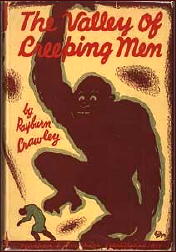Wed 19 May 2010
Reviewed by Walter Albert: RAYBURN CROWLEY – The Valley of Sleeping Men.
Posted by Steve under Authors , Reviews[6] Comments
RAYBURN CROWLEY – The Valley of Creeping Men. Harper & Brothers, hardcover, 1930. Hardcover reprint: Grosset & Dunlap, no date.
This is a book that any lover of high adventure, goofy science, and lost-race novels won’t be able to put down.

Somewhere in Africa, protected from the outside world by a forbidding mountain lies a valley in which — legend has it — dwells a race of golden gorillas, somewhere on the evolutionary scale between ape and man:
The murder in London of the brilliant but loony scientist Marakoff — the discoverer of the gorilla — sets off an international pursuit that includes more murders, treachery and relentless peril.
There’s some colorful writing here, the kind that always sets my pulse to pounding:
And away we go. The women are seductively beautiful, the men strong and intense, and the landscapes are painted with a skill that’s a cut above some of the plotting:
Edgar Rice Burroughs, eat your heart out!
In an appendix at the end of Chattering Gods, the sequel to Valley, published by Harper in 1931, the publisher poses the question “Who IS Rayburn Crawley?”
In an accompanying letter, Crawley defends his anonymity by claiming that: “Any author worth reading can be known, and very fully known, by his books.”
The publisher calls this a challenge and, listing several questions that might be asked about the reclusive author, offers autographed copies of the two books to “the persons who answer these questions correctly.”
Laura Spencer Portor Hope and Dorothy Giles are identified in the current version of Hubin as the authors hiding behind the Crawley pseudonym, and Victor Berch has added that their identity was known as early as July 7, 1958, when the copyright on the book was renewed.
Now if only somebody could find out the names of the winners of the Harper contest. It’s intriguing, to say the least, that autographed copies, in dust jacket, of the two books may be in some collector’s private library.
Editorial Comments: Walter sent me this review after he spotted this book in Victor Berch’s “Checklist of Harper’s Sealed Mysteries,” announced on this blog not too long ago. This is a revised version of a review he wrote some 20 odd years ago, and he admits that he’s been wondering about the author’s identity ever since.
As good as Walter says this book is, why it should have been published as a Sealed Mystery, along with the John Dickson Carr’s, Hulbert Footner’s and others is another mystery that’s lost in the mists of time.
May 19th, 2010 at 10:08 pm
Jungle drums, lost tribes, a mysterious valley, threatening mountain protecting it, murder, loony scientist …
You’ve convinced me. In fact you had me at lost tribes.
Incidentally a lost race of intelligent apes also features in Sapper’s ISLAND OF TERROR (aka GUARDIAN OF THE TREASURE) the second book and only novel to feature series character Jim Maitland, though from the exerpts this one sounds a bit better written.
For a modern variation on the theme and setting check out Paul McAuley’s fine thriller WHITE DEVILS which manages all the thrills plus touches of Michael Crichton, Joseph Conrad, J.G. Ballard’s DAY OF CREATION, and Graham Greene’s African novels. I guess they do write them like that still — if you know where to look.
But this one and its sequel are clearly going on my wish list.
May 19th, 2010 at 11:05 pm
David
I’m ahead of you on that last line. I’ve already ordered both from abebooks. Not in jacket, though. Jackets are on _my_ wish list, and probably will stay there.
— Steve
May 19th, 2010 at 11:11 pm
On books from this period dust jackets are often on the wish list. At least you found one we could see.
May 20th, 2010 at 2:30 am
The pictured book jacket shows the title to be “The Valley of CREEPING Men”, rather than “Sleeping”: and a quick googling under that title seems to agree.
You may want to correct the title for your archives…
May 20th, 2010 at 10:24 am
Rick
I’ve made the correction. Thanks! It was my error, not Walter’s, and especially not Victor’s. It’s been correct all along in his list of Harper’s Sealed Mysteries.
— Steve
May 21st, 2010 at 4:08 pm
Thanks, Steve, for pointing out that I originally published this review twenty years ago. I certainly fell for it hard at that time but haven’t looked at it again since. I did finally (this week) read the sequel, “Chattering Gods.” It’s uneven but still enjoyable, although an English character with a lisp greatly tried my patience. Fortunately, his role is minor.
A line in the last page of the novel leads me to believe that a third installment was planned. It would probably have involved the Jungle Princess (sorry about that, Dottie) character, Marnia, whose unfeeling acceptance of the loss (I won’t be more specific) of her longtime protector, Somba, the giant yellow ape, made me much less susceptible to her charms that the expedition leader was.
The best scene in the book is the revelation of the fate of the lost race that once ruled in the valley, untold eons ago. Now that’s a moment to feed the enthusiasm of any fan of Haggard or Burroughs.